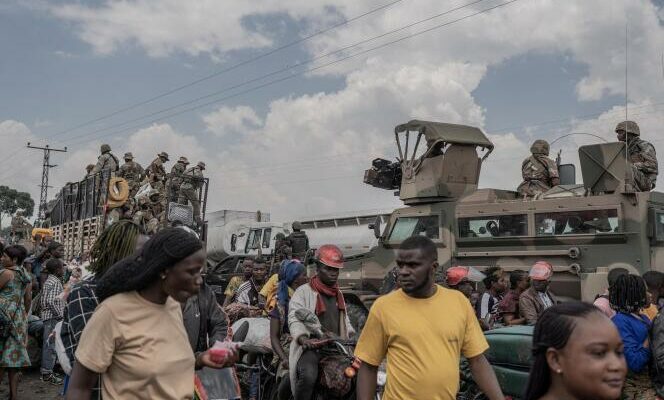It’s hard to imagine a worse start. Just two days after the official announcement of the deployment of a contingent of 2,900 men in the eastern Democratic Republic of Congo (DRC), the South African army lost two soldiers, killed in the mortar attack from one of its bases, Wednesday February 14. Expected losses, whistles the opposition, which denounces the deployment of an under-equipped army in a complex theater where many others have broken their teeth before it.
If the government was slow to formalize their mission, South African forces deployed as part of an offensive mandate from the Southern African Development Community (SADC) have been present in the DRC since mid-December 2023, at the request from Kinshasa, in order to support the Congolese armed forces (FARDC) in their fight against the March 23 Movement (M23), a rebel group which relaunched an offensive in early February. According to reports from the UN Panel of Experts, it is actively supported by neighboring Rwanda.
The southern African force succeeds an East African Community (EAC) force, asked by the Congolese government to leave barely a year after its deployment in November 2022. The peacekeeping force of the United Nations (MONUSCO) is also preparing to withdraw without tangible results after twenty-five years of presence in a region destabilized by a myriad of armed groups. Unpopular, they were considered by the Kinshasa authorities as too passive.
Deterioration in the state of defense forces
The main component of the SADC mission, does the South African army have a chance of succeeding where so many others have failed? Unthinkable, believes MP Kobus Marais, specialist in defense issues for the Democratic Alliance, the main South African opposition party, who has long warned about the deterioration in the state of his country’s defense forces which he judges that they “do not have the capacity to effectively lead a counter-insurgency campaign against the M23 rebels”.
“Our army can’t even plant cabbages”, also summed up, in his own way, the radical left troublemaker, Julius Malema, accusing President Cyril Ramaphosa of sending soldiers to their deaths. An observation generally shared by specialists who underline the growing gap between the missions of the South African army and its financing. Already present in the DRC within MONUSCO, South African soldiers are also deployed alongside the Mozambican army facing jihadist violence in the north-east of the country. They are also called upon on national territory to control border crossings, defend power plants against sabotage or even fight against illegal mining.
“The authorities ask them to be everywhere without the funding following”, notes Theo Neethling, professor of political science at the University of the Free State and familiar with defense issues. While its missions are expanding, the budget of the South African army is being reduced to nothing. It further decreased by 500 million rand (around 25 million euros) in 2023. “The budget of the South African defense forces represents less than 1% of GDP, it is totally underfunded compared to what is done in the world on average”continues the professor.
The South African army, a shadow of itself
Consequence: the South African army wasted away. The one that was considered one of the most powerful – if not the most powerful – on the continent forty years ago is now only a shadow of itself. In May 2023, the Minister of Defense herself, Thandi Modise, spoke of the need to “save the South African Defense Force” in front of Parliament. On paper, the army still has respectable equipment, “but many devices are not usable for one reason or another”explains Theo Neethling.
In the Congolese context, the most worrying of these shortcomings is to be found in the air fleet. Of the 39 Oryx transport helicopters South Africa has, only five were operational as of last October. “Let’s be honest, it’s shocking. And of course, there’s no money to maintain the Rooivalks so we don’t have attack helicopters. We cannot carry out a counter-insurgency without appropriate air assets”explains Piers Pigou, head of the Southern Africa program at the Institute for Security Studies (ISS), an African think tank.
Follow us on WhatsApp
Stay informed
Receive the essential African news on WhatsApp with the “Monde Afrique” channel
Join
He sees in the attack on the South African base on Wednesday in the DRC a testimony to the vulnerability of the troops in the face of a rebellion much better prepared than that of the jihadists in Mozambique, which the South African army is already struggling to contain. “The Mozambican rebels are a troop made up of odds and ends, they may have collected mortars and other weapons, but they don’t know how to use them. The M23 is another story. He has a rather sophisticated arsenal and is well trained. »
In a confidential document revealed by AFP on February 12, the UN wrote that one of its observation drones was recently targeted by a surface-to-air missile. “presumed to belong to the Rwandan defense forces”fired from an area controlled by the M23. “If the M23 decides to launch a serious attack on our bases, there could be heavy losses”thus alerts Piers Pigou, who deplores the deployment of a “counterinsurgency on the cheap”.
Since the end of apartheid, South Africa has made it a duty to take part in peacekeeping missions on the continent. But after thirty years of chronic underinvestment, does it even have the means? “We still talk as if we have double the capacity that we actually have. Either we reconfigure deployments abroad by reconsidering what we can actually bring there, or we invest significantly in security services”summarizes the head of the Institute for Security Studies.
